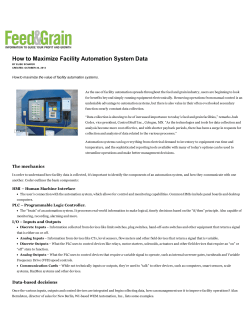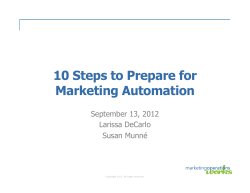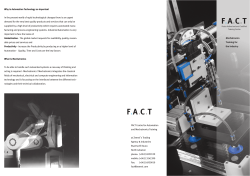
How to solve your toughest impediments? Jef Cumps @jcumps
How to solve your toughest impediments? Jef Cumps @jcumps A3 problem solving Jef Cumps @jcumps Deming quality cycle: PDCA A3 mindset • Objectivity • Results and process driven • Synthesis, distillation and visualization • Seek alignment and ensure progress Problem solving A3 Title Background Owner, date Countermeasures Current condition Goal Effect confirmation Root cause analysis Follow-up actions Problem solving A3 Title Owner, date Background Countermeasures DO Current condition Goal PLAN Root cause analysis Effect confirmation CHECK Follow-up actions ACT ACTION! ü Agree on 1 tough and common impediment within your group! ü Pick 1 person that suffers from the impediment as the ‘Owner’ of the A3. Problem solving A3 Test automation to boost customer satisfaction! Background XXX project, 2-monthly releases, highly visible to many different customers, pilot for Scrum Current condition Too many bugs found after first 3 releases: resp. 24, 32 and 29 important or critical bugs. à customers unhappy and risk of loosing market share due to ‘bad quality image’ of product. First 2 customers left: 280k€ loss! Goal Get good quality image + don’t loose any more customers by lowering bug rates to: à 0 critical bugs per release à < 3 important bugs per release Marcus W. 1/9/2012 ACTION! ü Build first 3 parts from the A3: • Background • Current condition • Goal Problem solving A3 Test automation to boost customer satisfaction! Background XXX project, 2-monthly releases, highly visible to many different customers, pilot for Scrum Current condition Too many bugs found after first 3 releases: resp. 24, 32 and 29 important or critical bugs. à customers unhappy and risk of loosing market share due to ‘bad quality image’ of product. First 2 customers left: 280k€ loss! Goal Get good quality image + don’t loose any more customers by lowering bug rates to: à 0 critical bugs per release à < 3 important bugs per release Root cause analysis Why? Too much last minute testing before release Why? Testing not in Sprint ‘Definition of Done’ Why? Not possible to test everything inside Sprint Why? All manual tests, no test automation Why? No knowledge/experience of test automation + no management support Marcus W. 1/9/2012 ACTION! ü Build ‘Root cause analysis’ part from the A3, using 5 Why’s. Problem solving A3 Test automation to boost customer satisfaction! Marcus W. 1/9/2012 Background Countermeasures XXX project, 2-monthly releases, highly visible to many different customers, pilot for Scrum - Explain value of test automation to mgmt + get support for next steps (John, 15/9) Current condition - Put automated unit and acceptance tests in D.O.D from Sprint 15 onwards (expected velocity drop: 40-50% in first 4-5 sprints to learn + catch up) Too many bugs found after first 3 releases: resp. 24, 32 and 29 important or critical bugs. à customers unhappy and risk of loosing market share due to ‘bad quality image’ of product. First 2 customers left: 280k€ loss! Goal Get good quality image + don’t loose any more customers by lowering bug rates to: à 0 critical bugs per release à < 3 important bugs per release Root cause analysis Why? Too much last minute testing before release Why? Testing not in Sprint ‘Definition of Done’ Why? Not possible to test everything inside Sprint Why? All manual tests, no test automation Why? No knowledge/experience of test automation + no management support - Get automation expert into Sprint 14 (cost € 7.600) to setup C.I. and teach us automation (by pair programming) Effect confirmation Velocity 80 70 60 50 40 30 20 10 0 12 13 14 15 16 17 18 19 20 21 22 23 24 25 26 27 28 29 30 CRITICAL IMPORTANT 30 25 20 15 10 5 0 R1 R2 R3 R4 R5 ACTION! ü Build ‘Countermeasures’ part from the A3. Try to get actions as SMART as possible! (Specific, Measurable, Achievable, Realistic, Time bound) Problem solving A3 Test automation to boost customer satisfaction! Marcus W. 1/9/2012 Background Countermeasures XXX project, 2-monthly releases, highly visible to many different customers, pilot for Scrum - Explain value of test automation to mgmt + get support for next steps (John, 15/9) Current condition - Put automated unit and acceptance tests in D.O.D from Sprint 15 onwards (expected velocity drop: 40% in first 5 sprints to learn + catch up) Too many bugs found after first 3 releases: resp. 24, 32 and 29 important or critical bugs. à customers unhappy and risk of loosing market share due to ‘bad quality image’ of product. First 2 customers left: 280k€ loss! Goal Get good quality image + don’t loose any more customers by lowering bug rates to: à 0 critical bugs per release à < 3 important bugs per release - Get automation expert into Sprint 14 (cost € 7600) to setup C.I. and teach us automation (by pair programming) Effect confirmation Velocity 80 70 60 50 40 30 20 10 0 Root cause analysis Why? Too much last minute testing before release Why? Testing not in Sprint ‘Definition of Done’ Why? Not possible to test everything inside Sprint Why? All manual tests, no test automation Why? No knowledge/experience of test automation + no management support 12 13 14 15 16 17 18 19 20 21 22 23 24 25 26 27 28 29 30 CRITICAL IMPORTANT 30 25 20 15 10 5 0 R1 R2 R3 R4 R5 Follow-up actions - Share automation and C.I. knowledge with other teams - Learn more about ATTD and start implementing it Problem solving A3 Title Owner, date Background Countermeasures Any background information that is essential to understanding the extent and importance of the problem. List of necessary actions to address / solve the root causes of the problem. Include: Current condition • What must be done Clear and simple overview of current process + fact-based understanding of the problem. Quantify the ‘pain’ you’re suffering. • Who is responsible Try to use visual elements (chart, drawing, table, …) to enhance understanding! • How (approach) it is best done • When it should be done Goal Effect confirmation Clear definition of desired outcome, including metrics to measure success. Tracking of the metrics defined in the Goal section, to assure that the defined countermeasures were the right ones to reach the goal, and that they were properly executed. Also, quantify the gain of reaching this goal! Root cause analysis Follow-up actions Investigation of the root cause(s) of the problem stated in the current condition. Reflection on what further changes should be made to reach the goal (maybe countermeasures need to be adapted or added). Also further actions needed to sustain the improvement on the long term. Dig deep enough to find the deeply rooted seeds of the problem! Good techniques for root cause analysis are 5 Why’s or a Fishbone diagram. © Jef Cumps, iLean, 2012 Questions? Thank you! Feel free to contact me! jef@iLean.be - @jcumps www.iLean.be
© Copyright 2025


















